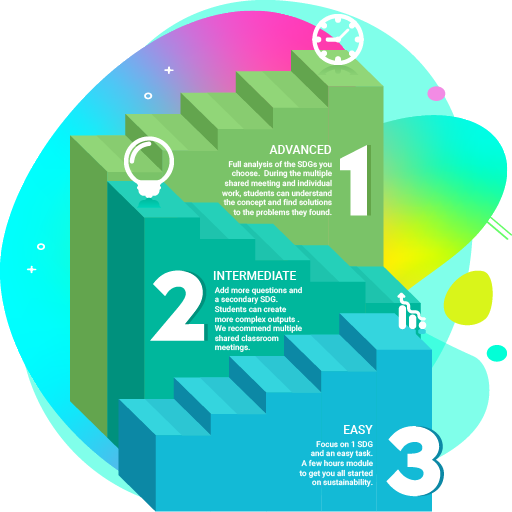CHOOSE YOUR LEVEL OF SUSTAINABILITY
Regardless of who we are, where we live, and what we do, we all have a moral obligation to each other, our future generations, and other species to sustain the planet. Our present choices and actions have huge long-term impacts on future generations. Practicing sustainability ensures that we make ethical choices that bring a safe and livable future to everyone.
Because of this, teaching young generations how important is to be aware and face current issues ( which are presented by SDGs) is the starting point to solve them. Therefore, teachers play an important role guiding next generations on a sustainable living and the SCLASS project aims to make it international.
In this website, we aim to guide you through the creation and use of teaching modules on SDGs with the PBL approach.
You can modify and apply these teaching modules according to the necessity of your timetable and your class needs. Teaching modules are thought to be structured from an easy level – just few hours in one shared meeting with students from another country – to an advanced one – analysis on more SDGs that required more meetings and some individual work.
Do you need more prompts? Let’s check the teaching modules we created during the project and feel free to use them as you prefer. You could simply download them and use them as they are or adjust them to your needs.
Experiment and create new teaching modules based on the topics you think are more important for your students.

Share your classroom with blended learning: Students collaborate in inquiry, they share their findings and find local actions for the SDGs.
The process is undertaken like this:
- Two teachers across borders set up their own frame for an SCLASS project, in terms of SDGs, time, and objectives
- Each teacher outlines the project to the students and introduces the SDGs in focus
- The classes get acquainted through online meetings on an agreed communication platform. E.g.: Teams, Zoom, Google Meet among They team-up in project groups for comparative inquiries into the SDGs
- The students starts finding relevant problems and research their subject. Classes use teachers for scaffold/help
- Students meet online to present progress and build relationships
- The SCLASS project is complete when the two classes have presented their work, compared their solutions in shared classrooms online and worked with perspectives for local action
Teaching Modules include:
- Primary and secondary SDGs in focus
- Problem statement, working questions and links to material
- Schedules with varying duration and structure of shared classroom sessions
